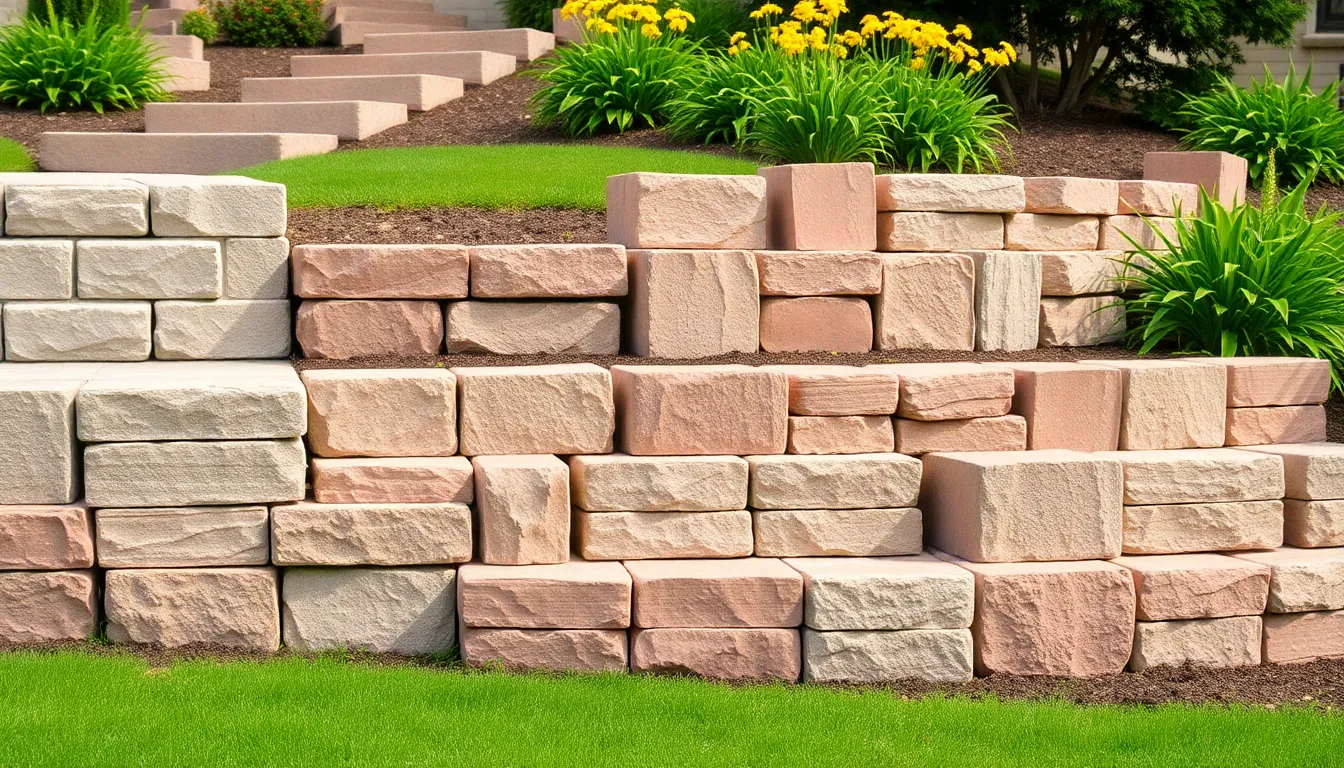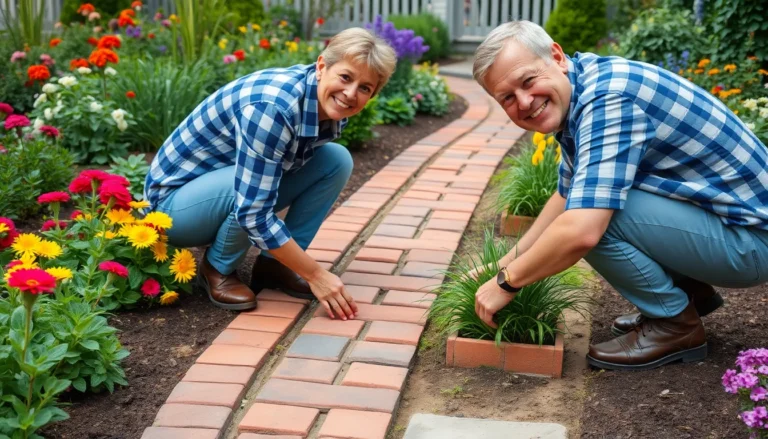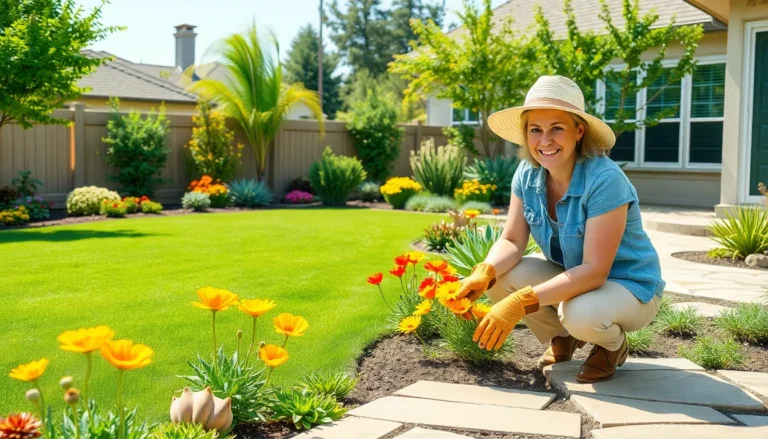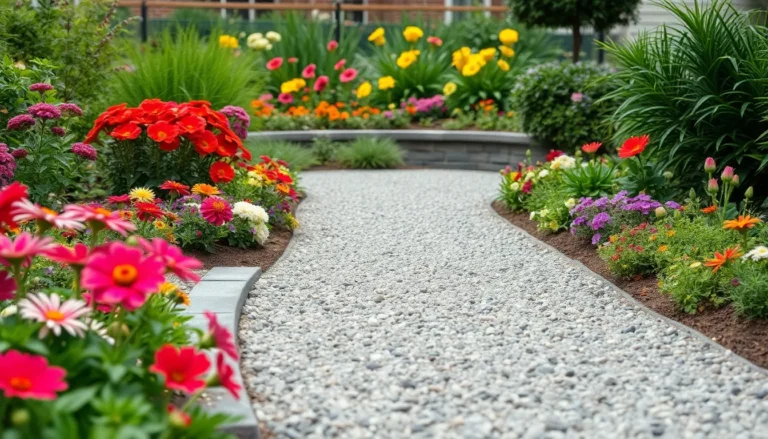When it comes to transforming outdoor spaces, landscaping blocks are the unsung heroes of the garden world. These versatile little wonders can turn a bland backyard into a stunning sanctuary faster than you can say “curb appeal.” Whether it’s a cozy fire pit, a winding pathway, or a sturdy retaining wall, landscaping blocks are like the Swiss Army knife of the landscaping realm—ready for any project that comes their way.
Landscaping Block
Landscaping blocks serve crucial purposes in both functionality and aesthetics for outdoor spaces. Various types of landscaping blocks include concrete, stone, and brick, each offering unique characteristics. These blocks provide strength and stability for structures like retaining walls, which manage soil erosion effectively.
Creating pathways using landscaping blocks enhances the design and usability of gardens. Durable materials withstand weather conditions while ensuring longevity in outdoor applications. Customized shapes and sizes give designers flexibility in crafting unique features that meet specific garden themes or personal preferences.
Fire pits constructed with landscaping blocks contribute additional charm and social opportunities to outdoor spaces. They create inviting areas for families and friends to gather, enhancing outdoor enjoyment during cooler evenings. Additionally, landscaping blocks can facilitate eco-friendly solutions, such as permeable paving, which promotes water drainage.
Cost-effective options exist within landscaping blocks, with a vast range of prices making them accessible for various budgets. DIY enthusiasts often appreciate the ease of installation for many block types, which reduces labor costs significantly. Seasonal promotions or bulk purchasing frequently lower financial barriers to acquiring landscaping blocks.
Sustainability becomes a trend with the choice of recycled materials for landscaping blocks. These eco-conscious options provide environmentally friendly alternatives while maintaining durability and beauty. Homeowners and landscapers favor landscaping blocks for not only their versatility but also their capacity to enhance the quality of outdoor living spaces.
Types of Landscaping Blocks

Landscaping blocks come in various types, each suited for specific applications and design preferences. Understanding these types can help homeowners and landscapers make informed choices for their outdoor spaces.
Concrete Blocks
Concrete blocks stand out for their affordability and versatility. These materials can form various structures like walls and pathways. They’re available in multiple sizes and finishes, catering to diverse aesthetic preferences. Concrete blocks possess excellent durability, ensuring they withstand harsh weather conditions. Additionally, they can be colored or textured, enhancing their visual appeal in landscaping projects.
Natural Stone Blocks
Natural stone blocks offer a timeless appeal and unique characteristics. Each piece showcases distinct colors and textures, creating a visually striking landscape. These blocks provide superior strength and stability for retaining walls and pathways. Landscaping utilizing natural stone blends seamlessly with surrounding elements, enhancing the overall design. Homeowners appreciate their long-lasting nature, making them a worthwhile investment for outdoor spaces.
Retaining Wall Blocks
Retaining wall blocks play a crucial role in managing soil erosion and creating level surfaces. They can support landscapes in sloped areas effectively. Availability in various styles and sizes allows for customization, enabling unique designs and layouts. Many modern retaining wall blocks incorporate interlocking systems for added stability. These blocks not only serve structural purposes but enhance aesthetics, providing a polished look to gardens and yards.
Benefits of Using Landscaping Blocks
Landscaping blocks offer numerous advantages that enhance outdoor spaces significantly. These benefits include durability, aesthetic appeal, and versatility in design.
Durability and Longevity
Landscaping blocks exhibit exceptional durability. Concrete blocks resist weathering, ensuring structures maintain integrity over time. Natural stone blocks withstand environmental elements, providing long-lasting solutions for outdoor projects. Retaining walls constructed with these materials remain sturdy and functional, managing soil erosion effectively. Outdoor features crafted from landscaping blocks endure heavy foot traffic and prevent wear from the elements. Homeowners find assurance in knowing their investments stand the test of time.
Aesthetic Appeal
Visually, landscaping blocks deliver impressive aesthetic appeal. Available in various colors and textures, these blocks complement diverse architectural styles. Homeowners utilize concrete or natural stone options to achieve looks that match personal tastes. Fire pits designed with landscaping blocks create inviting focal points in gardens. Pathways crafted from these blocks enhance overall landscape design, guiding guests through outdoor spaces. The combination of functionality and beauty contributes to inviting environments.
Versatility in Design
Design versatility defines landscaping blocks. These materials adapt to numerous landscaping projects, including retaining walls, pathways, and fire pits. Creative landscapers incorporate different block types in innovative ways. Interlocking systems allow for unique configurations and layouts, enabling customized designs. Homeowners also appreciate easy installation, often opting for DIY projects to craft their outdoor visions. Landscaping blocks support imaginative landscaping solutions, transforming ordinary areas into stunning spaces.
Installation Process
The installation process for landscaping blocks involves several essential steps. These ensure a stable and attractive outdoor feature.
Preparing the Site
Begin by surveying the area where the landscaping blocks will be installed. Clear the site of any debris, vegetation, or existing structures that might impede the installation. Leveling the ground is crucial, with specific attention to ensuring a uniform surface. Excavation may be needed for structures like retaining walls to ensure stability. After excavation, lay down a compact base using gravel or sand for proper drainage. This foundation supports the blocks, preventing settling over time. Proper preparation sets the stage for a successful installation.
Laying the Blocks
Start laying the landscaping blocks in a straight line or according to the desired design. Use a level to ensure each block sits evenly and maintains uniform height. Stagger joints between rows to enhance stability, particularly for walls. Straight-edge tools help maintain alignment and levelness. Take care to leave appropriate gaps between blocks for drainage, especially in retaining wall applications. Utilizing concrete adhesive can further enhance the integrity of the setup. Following these guidelines leads to a sturdy and visually appealing project.
Finishing Touches
After laying the blocks, fill gaps with sand or soil to stabilize them firmly. Properly compact the material, ensuring it settles without shifting. Adding decorative elements, such as gravel or plants, enhances the aesthetic appeal. Ensure drainage is effective by checking that water flows away from the blocks. Lastly, inspect the entire structure for any misalignment, making necessary adjustments. Finishing touches complete the project and enhance its overall functionality and beauty.
Maintenance Tips for Landscaping Blocks
Regular upkeep ensures landscaping blocks maintain their appearance and structural integrity. Inspect the blocks periodically for cracks, chips, or shifting, allowing for early detection of potential issues.
Cleaning the surface prevents dirt and algae accumulation. Use a power washer for stubborn stains or moss, as this method removes debris effectively without damaging the blocks.
Weeds can disrupt the aesthetics of landscaping blocks. Applying a polymeric sand in the joints minimizes weed growth and stabilizes the blocks, extending their lifespan.
Sealing the blocks enhances their durability and appearance. Select a high-quality sealant designed for the specific type of block, applying it every few years to protect against moisture and stains.
Addressing drainage issues promptly avoids long-term damage. Ensure that water drains away from the blocks, preventing erosion or shifting caused by excessive moisture.
Routine maintenance enhances the visual appeal of the landscape. Prune surrounding plants to maintain clarity around the blocks and remove any overgrowth that obscures their design.
Winter preparations are particularly important in colder climates. Clear snow and ice promptly to prevent buildup, reducing the risk of freeze-thaw damage.
Enhancing the landscape’s vibrancy involves simple updates. Adding fresh gravel or mulch around the blocks can redefine the space, providing a finished look that accentuates the features.
In selecting materials for repairs or replacements, match the original blocks closely. This approach ensures a cohesive look while maintaining the overall design and functionality of the outdoor space.
With proactive measures in maintenance, landscaping blocks can continue to enhance outdoor spaces for years.
Conclusion
Landscaping blocks are invaluable assets for anyone looking to elevate their outdoor spaces. Their versatility allows for creative designs while providing essential functionality. With options ranging from concrete to natural stone, homeowners can choose materials that fit their aesthetic and practical needs.
The ease of installation and maintenance makes landscaping blocks an appealing choice for DIY enthusiasts. By investing in these durable materials, individuals can create stunning features that withstand the test of time. Embracing sustainable practices with recycled options further enhances their appeal.
Ultimately, landscaping blocks not only enhance the beauty of gardens but also contribute to the overall enjoyment of outdoor living.




